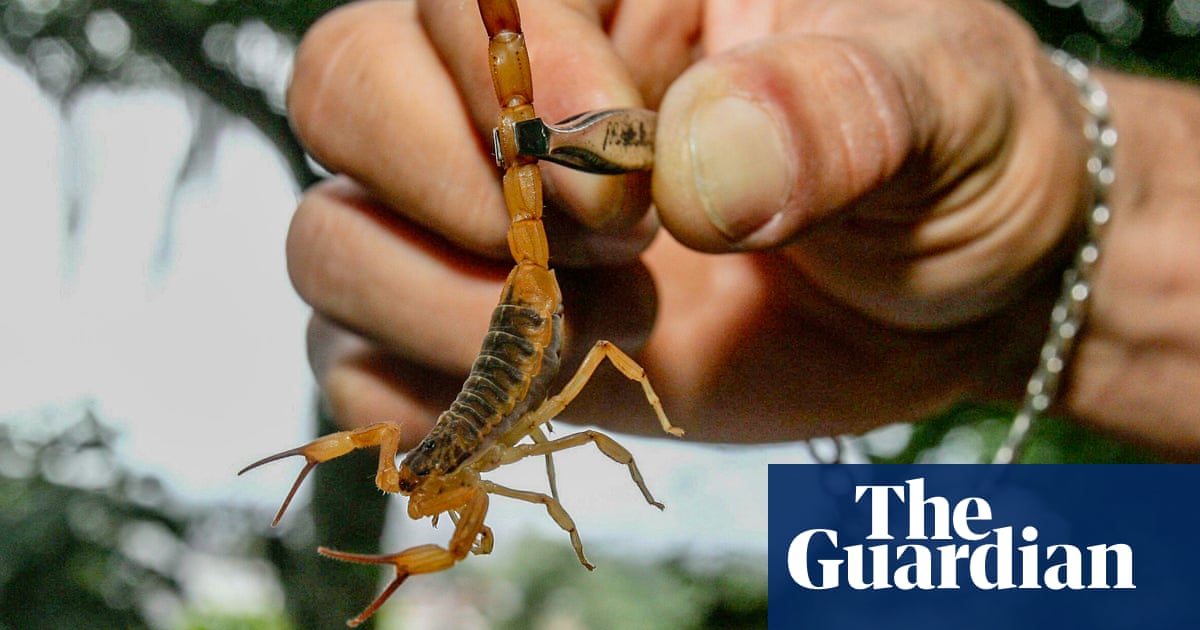Scorpions are “taking over” Brazilian cities, researchers have warned in a paper that said rapid urbanisation and climate breakdown were driving an increase in the number of people being stung.
More than 1.1m stings were reported between 2014 and 2023, according to data from the Brazilian notifiable diseases information system. There was a 250% increase in reports of stings from 2014 to 2023,according to researchpublished in the journal Frontiers in Public Health.
The rise in cases has been driven by rapid, unplanned urbanisation–such as favelas – characterised by high-density housing and poor waste disposal, according to the research. Although urban areas are encroaching on wild habitats where scorpions already live, they are also creating new environments in which to thrive.
“Urbanisation in Brazil has profoundly reshaped ecosystems,” said the lead researcher, Manuela Berto Pucca, an assistant professor at São Paulo State University. “Cities unintentionally offer everything scorpions need: plenty of shelter (in walls, drains, rubble and construction debris), consistent warmth, and a reliable food supply in the form of cockroaches and other urban invertebrates.”
They particularly like sewers, which are warm year-round, home to almost no predators and provide plenty of food, especially cockroaches. Some species of scorpion can survive forup to 400 dayswithout food and are able to reproduce without mating, making them difficult to eradicate.
Hotter summers, and periods of intense rainfall and drought, also help them thrive as they are adapted to warm and humid environments.
Provisional datafor 2024 suggests scorpions were responsible for nearly 200,000 stings and 133 deaths in Brazil. In total, researchers projected 2m new cases between 2025 and 2033. “The real scale of this issue is likely far greater than the recorded statistics suggest,” researchers said, as many people choose to treat themselves at home, or forgo treatment.
“I’ve been working in places where scorpion stings are a daily fear, especially in poor and crowded areas,” said Pucca. “The numbers showed us that in the future the problem will be bigger than it is now.”
Researchers said that 0.1% of reported stings result in death, and children and elderly people are most vulnerable. Healthy people generally make a full recovery, but can suffer from pain and discomfort for several days. Symptoms include pain, burning, swelling, redness, tingling and nausea.
Previous researchmodelling the distribution of scorpions in Brazil showed the potential to expand their habitats into urban areas driven by a warmer, wetter climate.
Brazil, Paraguay, Bolivia, Mexico, Guyana and Venezuela have witnessed a “particularly alarming rise in scorpionism [the medical condition resulting from a sting]over recent decades, evolving into a significant public health crisis”, theresearchers of the new study said. In Europe there are believed to bemore than 35 native speciesof scorpion, although there is no comprehensive research on population trends.
Researchers said prevention was key. “Scorpions thrive in cluttered, humid environments. Keep areas clean, seal cracks in walls, use screens on drains and always check shoes, towels and clothes before using them,” said Pucca.
Dr Manuela González-Suárez, an ecologist at Reading University who was not involved in the research, said: “The numbers are much higher than I would expect, in the sense that this is a significant increase.” However, she said awareness of an issue could also result in more reporting.
González-Suárez added that people should not be unduly alarmed by the research: “Many people who are stung do not have severe or lethal reactions and mortality rates are relatively low compared with, for example, those due to road accidents or violent crimes.”
The Brazilian health system provides free treatment for scorpion stings, and anti-venom is available at some hospitals and emergency centres. “If someone is stung, don’t wait for symptoms to worsen – go to the nearest healthcare facility immediately,” said one of the paper’s authors, Prof Eliane Candiani Arantes from the University of São Paulo.
“All people are vulnerable, especially children, because just one small sting can kill a child,” she said.
Prof Nibedita Ray-Bennett, at the University of Leicester, who is president of theAvoidable Deaths Network, said the study underscored “the urgent need for action”.
Pucca said one of the most widespread misconceptions about scorpions was that they were our enemies. “They are not. These animals act defensively, not offensively. They’re part of the natural world and play essential ecological roles, from controlling pest populations to maintaining biodiversity.”
Find moreage of extinction coverage here, and follow the biodiversity reportersPhoebe WestonandPatrick Greenfieldin the Guardian app for more nature coverage
